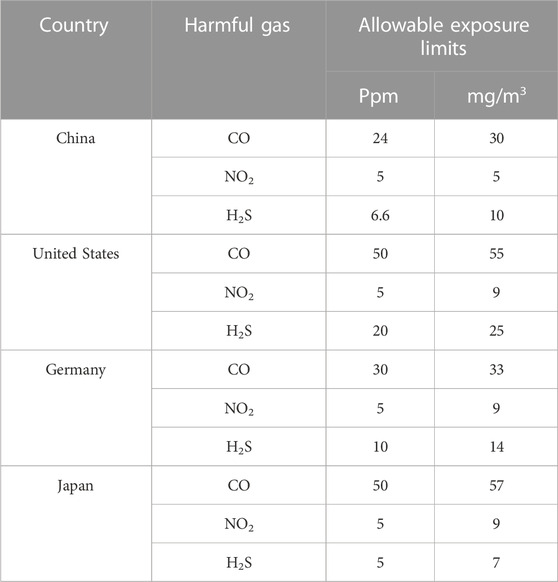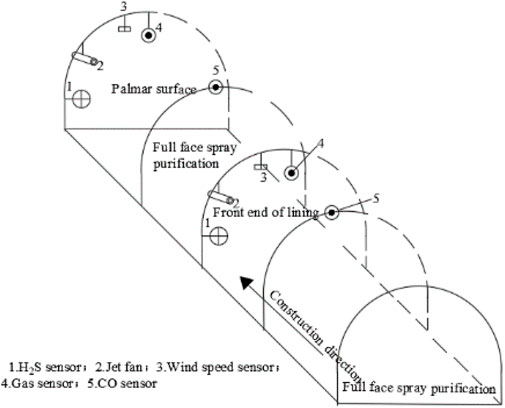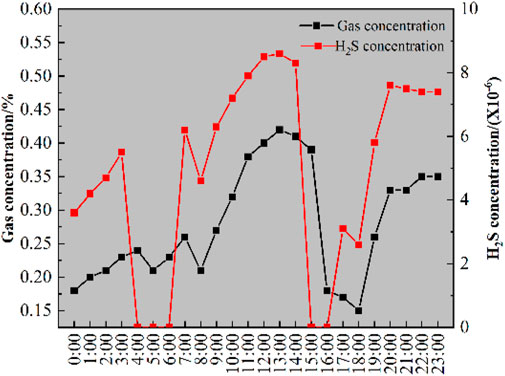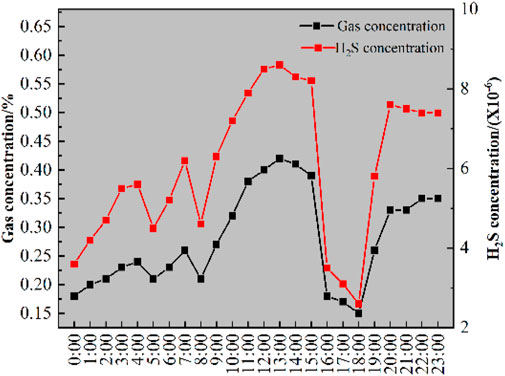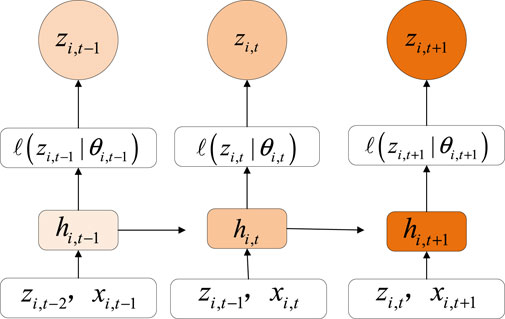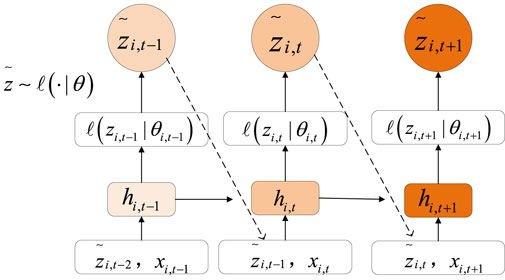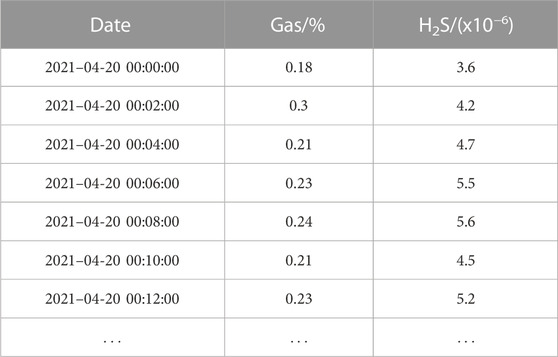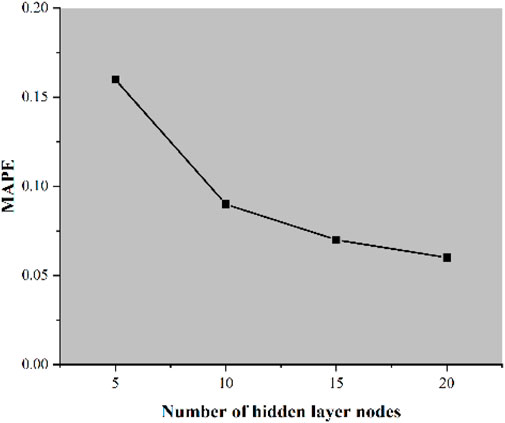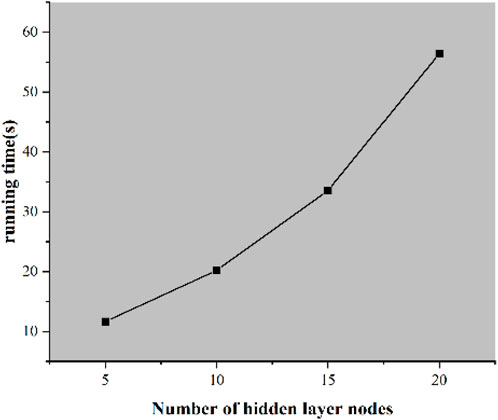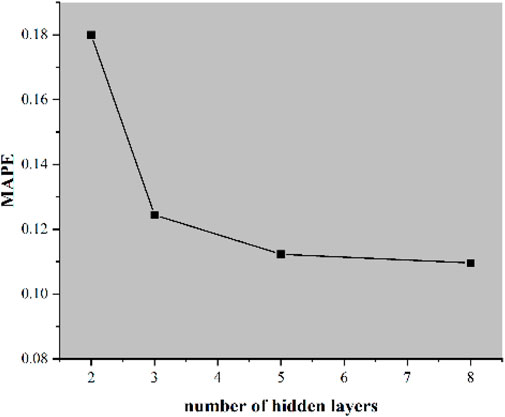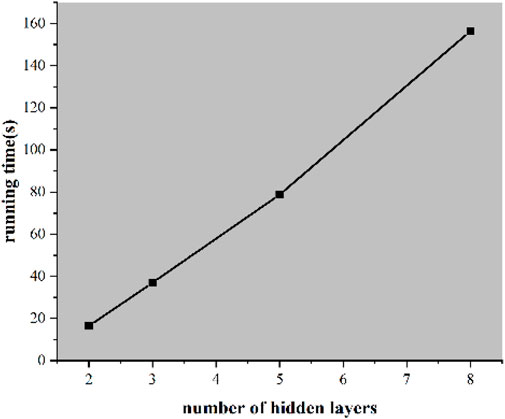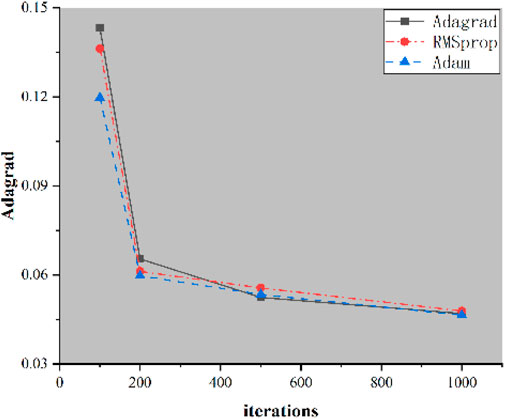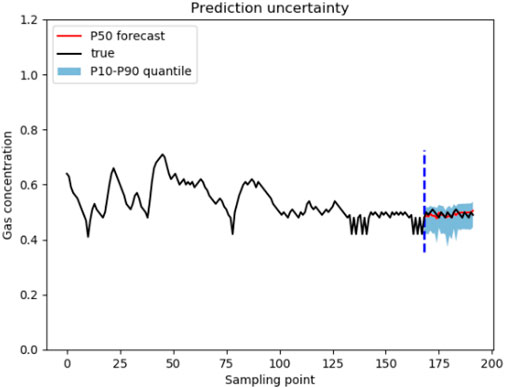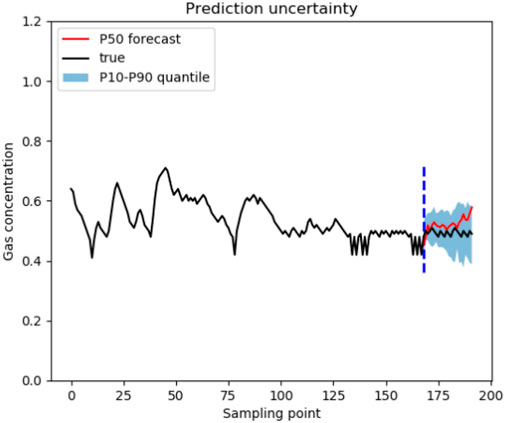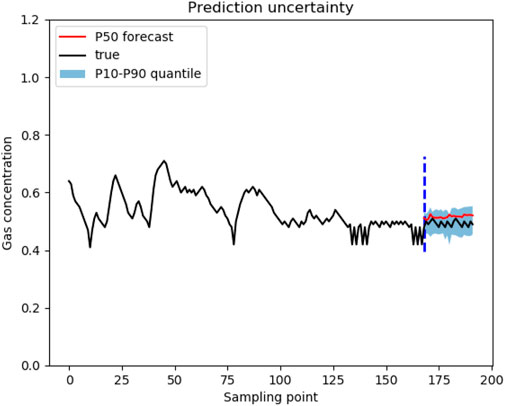- 1Qinghai Province Huangyuan Highway Engineering Construction Co., Ltd., Qinghai, China
- 2China Merchants Chongqing Transportation Research and Design Institute Co., Ltd., Chongqing, China
- 3National Engineering Research Center of Highway Tunnel, Chongqing, China
Effective real-time treatment and control of harmful gases are key to ensuring the safety of tunnel construction workers. Currently, the monitoring ability of harmful gases is insufficient to match the processing needs, which poses significant risks to the safety of tunnel construction workers. This paper proposes an advanced perception and treatment method for harmful gases during tunnel construction, utilizing the DeepAR algorithm. Real-time monitoring of the concentration and diffusion of harmful gases is conducted, and a harmful gas concentration prediction model is established using the DeepAR algorithm, achieving advanced perception of harmful gases during tunnel construction. The harmful gas treatment plan is developed in advance, and the effectiveness of the proposed method is demonstrated by simulation testing under realistic field scenarios and comparing with other prediction models. The method was applied in a coal mine tunnel in Qinghai Province, achieving an accuracy rate of 94.3%, which is higher compared to those obtained using RNN and LSTM algorithms. Moreover, the computational time is less than 60 s. The method provides timely perception of the concentration distribution of harmful gases in the tunnel and proposes targeted treatment measures, verifying the effectiveness of the prediction model from the perspective of practical engineering application.
1 Introduction
With the continuous development of modern transportation facilities, more and more underground tunnels, subway passages and underground spaces have been built and utilized. In modern tunnel construction, due to the complexity of construction methods and geological environment (Fei et al., 2010; He et al., 2017; Su et al., 2020), the concentration and diffusion law of harmful gases produced by different coal seam structures are different under coal-penetrating geological conditions (Zhang et al., 2023a; Liu et al., 2023), and the generation and aggregation characteristics of toxic and harmful gases such as gas and hydrogen sulfide need to be sensed in advance, which will effectively protect the health of tile workers in tunnel construction (Cao et al., 2016; Zhao et al., 2020; Gong et al., 2022). Excessive inhalation of harmful gases has a great negative impact on human respiratory system, circulatory system and nervous system, especially under continuous exposure to high concentration of harmful gases, workers may lose consciousness and even die. Therefore, how to effectively warn and control the concentration of harmful gases during tunnel construction, adopt effective methods to forecast harmful gases and take countermeasures in advance is of great practical significance to tunnel engineering practice (Kang et al., 2010).
Current toxic and harmful gas monitoring and detection methods rely on real-time sensing devices to monitor gases and take prompt action to prevent harm to construction workers and nearby environmental conditions (Chen et al., 2020). Nonetheless, the
Assessment and identification of dangerous gases during tunnel construction is greatly influenced by the location of sensor placement, the work conditions, and the number of sensors utilized in the process. Meanwhile, a range of geological factors contribute to differing amounts of toxic gases, their fluctuations, and overall trends during excavation, all of which pose formidable challenges for the real-time management and control of these gases, thereby endangering the wellbeing of construction personnel.
With the development, and application of deep-learning and artificial intelligence technology, using deep-learning-based time-series prediction models to make real-time predictions of noxious gas concentrations has shown extensive potential applications (Gong et al., 2015a; Zhang and Yang, 2017a; Wu and Fan, 2020). DeepAR, a deep-learning algorithm specially designed for the prediction of time-series data, holds high flexibility and prediction accuracy and has been widely applied across domains, including transportation, electricity, and finance (Salinas et al., 2020). However, pertinent research on the prediction and evaluation of noxious gas concentrations during tunnel construction lacks an adequate experimental foundation and having improvement schemes implemented.
This article presents a proactive approach to monitoring and mitigating the risks associated with harmful gases during tunnel construction, utilizing the DeepAR algorithm for effective prediction and control of gas concentrations. Firstly, existing technologies for monitoring and controlling harmful gases are extensively reviewed, including a detailed description of the data preprocessing process. Following this, various time series prediction algorithms are compared and analyzed to provide a comprehensive assessment of their respective advantages and limitations. The DeepAR-based model for predicting harmful gas concentrations is subsequently presented, with simulated results obtained from actual field scenarios compared and contrasted with other prediction models. Finally, a comprehensive discussion is made on the effectiveness of the DeepAR approach in mitigating harmful gas concentrations. The proposed method provides a new and promising means of minimizing harmful gas exposure during tunnel construction.
2 Overview of relevant work
The monitoring and early detection of hazardous gases has always been a crucial aspect of construction site safety. In China, the predominant method for mountain tunnel excavation is the drilling and blasting technique. This method boasts simple, versatile, and economically efficient equipment and facilities that can adapt to a wide range of geographical conditions and has been widely employed in China’s mountain-tunnel excavation processes. However, the use of drilling and blasting for excavation produces hazardous gases (Zhang et al., 2023b; Liu et al., 2023), which are more prone to accumulation in the relatively enclosed spaces of the tunnels. As a result, large-scale excavation works in tunnel construction lead to a buildup of hazardous gases on the tunnel surface, severely impacting the construction workers’ health. Therefore, it is imperative to address this issue promptly by effectively monitoring hazardous gases, predicting their diffusion and development laws in real-time during construction periods, and implementing appropriate countermeasures.
Domestic scholars have developed relevant standards and specifications to alleviate the construction of tunnels, and have made relevant regulations on the tunnel construction environment (Industry Standards of the People’s Republic of China, 2002; Indus try Standards of the People’s Republic of China, 2009; Industry Standards of the People’s Republic of China, 2000). For the CO concentration in the tunnel, it must not exceed 20 mg/m3 and in special conditions, when the time does not exceed 15 min, the concentration of CO must not exceed 30 mg/m3. CO2 calculated by volume should not be less than 0.5%; NO2 in nitrogen oxides should not be less than 5 mg/m3. At the same time, relevant standards and specifications also specify the highest allowable concentration of harmful gases during tunnel construction, time-weighted average allowable concentration and short-term exposure allowable concentration. Foreign standards for tunnel construction research have started relatively early, and Germany, the United States, and Japan have specified the concentration of carbon monoxide, nitrogen dioxide, and hydrogen sulfide during tunnel construction in Table 1.
According to the table, it is clear that China implements more rigorous standards. However, the ventilation method on tunnel construction sites still follows the traditional approach of “real-time monitoring before forced ventilation” which leads to poor effectiveness in treating harmful gas due to the inadequate awareness of gas diffusion patterns and range. Numerous studies have been conducted by domestic and international experts and scholars on the monitoring and treatment of harmful gases in tunnels. Matsumoto et al. built a numerical model to analyze the comprehensive impact of structural, geological, and environmental factors (Matsumoto et al., 1998). Liu et al. conducted numerical simulations to investigate the diffusion of harmful gases during tunnel excavation under press-in ventilation conditions, revealing the patterns and changes in the spread of these gases (Liu et al., 2009). Additionally, Liu et al. (2014) used Fluent simulations to explore the distribution of harmful gases during the rock breaking process at tunnel exits and to investigate the wind field characteristics and harmful gas distribution in the tunnel cavity during this process. Klemens et al. (2001) investigated the movement of tunnel dust and optimized the current ventilation methods based on this understanding of dust distribution patterns. Chen and Su, 2019 analyzed the features of harmful gases in tunnels and drew upon experiences and data from similar underground projects in geochemically comparable areas to provide a reference for studying harmful gases in metamorphic and magmatic rock areas. Lastly, Huo et al. (2023) applied the key stratum theory, fluid mechanics, and other theories to propose conditions for the failure of harmful gases in Jurassic goaf and establish a multi-parameter control equation for harmful gas discharge from Jurassic goaf to the coal seam working face.
During tunnel construction, various harmful gases are released, and their prediction and treatment is essential. Gong et al., 2015b addressed the problem of detecting multiple harmful gases by using the particle swarm optimization (PSO) algorithm to optimize the weights and thresholds of the BP neural network. They proposed a method that combined a sensor array with the BP neural network for monitoring multiple harmful gases. Fu, 2022 suggested corresponding preventive measures for gas outburst at different positions in the tunnel and developed a gas outburst prediction model based on the exponential smoothing method. Li (Li, 2017) proposed a wireless network technology that enables the transmission of video and audio data using 2.4G wireless signals and gas data using 470 MHZ wireless signals, thereby freeing the system from cable constraints. Ding, 2011 analyzed the factors affecting coal and gas outbursts, established two tunnel gas concentration prediction models using the exponential smoothing and curve trend prediction methods, and monitored the short-term gas concentration of the tunnel. Li (Li et al., 2022) tackled the problem of single control means, control lag, low efficiency, and poor effects of ventilation systems, and proposed a novel method using the fuzzy PID control technology based on an improved fuzzy logic theory for comprehensive treatment of various harmful gases. Wang, 2022 pointed out the drawback of using harmful gas content prediction technology based on quality sensors, which overly relies on sensor sensitivity and thus lowers the accuracy of harmful gas content prediction. They proposed a harmful gas content prediction technology based on sensitivity infrared sensors. Finally, to address the high cost of numerous geological drills used in previous studies that seriously affected construction progress, Zhang and Yang, 2017b used a comprehensive projection calculation method of tunnel-rock relationship to predict the occurrence location of harmful gases in the tunnel for the next phase.
3 Data preprocessing
During tunnel construction, harmful gases such as hydrogen sulfide, methane, and carbon monoxide are monitored using gas-collection sensors. Wind-speed sensors are used for information control and monitoring. To track the diffusion of gas, sensors are placed in various sections such as the leading end of the lining, the return air outlet, and the face of the excavation area. Figure 1 displays the distribution of these sensors.
Four types of monitoring sensors are used to continuously monitor gas concentrations inside the tunnel in two states, traditional ventilation diffusion and system purification through dilution and spraying. These sensors are programmed to automatically collect data every 5–60 s, which are then transmitted via a network to a central PC for storage.
The data collected from sensors are subject to limitations imposed by the operating environment. These limitations may result in erroneous, missing or duplicate data during the data collection process. Thus, data must be cleared and repaired to ensure their quality and reliability. In this study, we adopted the method of identifying harmful gas data anomalies to explore the original data and remove erroneous values. By drawing the time series graph of harmful gases, we were able to easily identify the exceptional data. For example, as shown in Figure 2, the hydrogen sulfide concentration and the methane variation of a collected data segment suddenly drop to zero, while adjacent data change normally, indicating data loss during the data collection of hydrogen sulfide concentration. Therefore, the data of this time period needs to be patched.
The collected raw data exhibits certain patterns. To address missing data, we employed time series analysis. Specifically, we utilized the sulfur dioxide data as a time series and employed the weighted mean method to estimate and fill in the missing data. As a result, we obtained a more comprehensive and reasonable trend of the data, as depicted in Figure 3. Similarly, after identifying all outliers in the raw data, we filled them in using time series analysis, thereby maintaining the integrity of our dataset.
When dealing with large volumes of raw data or data with high dimensionality, computing distances between different data can be extremely difficult. Additionally, utilizing random sampling to process data poses a risk of producing biased results, while still being unable to guarantee data completeness. To overcome these issues, data normalization becomes necessary, especially when dealing with data that possess varying dimensions. This paper utilizes the z-score method to normalize raw data. The z-score method ensures that data errors resulting from varying dimensions are eliminated. In the case of a data set on harmful gases, the z-score expression is utilized.
In the equation, y is the normalized value of harmful gases,
4 Prediction model based on DeepAR
4.1 Model building
Predicting changes in harmful gas concentrations during tunnel construction can aid in the early formulation of effective treatment plans and ensure the health and safety of workers. The gas concentration data is time-dependent, and can be viewed as time-series data. A wide range of time prediction algorithms are available, including the traditional statistical methods of ARIMA and exponential smoothing models. With the development of artificial intelligence, deep learning methods such as RNN, LSTM, and DeepAR have gradually been applied to time series prediction. Compared to traditional models, DeepAR is a self-autoregressive recurrent neural network-based time series probability prediction method. It can handle complex scenarios such as periodic and multi-variable time series, accurately predict the probability of large-scale time series through learning similar data, and is therefore used in this study to predict harmful gas in the tunnel construction period. Figure 4 and Figure 5 shows the training and prediction process, which comprises the following steps.
Step1:. the harmful gas data during the tunnel construction period was preprocessed, and the results were divided into training and testing sets. 70% of the data was used for the training set, and 30% for the testing set.
Step2:. the preprocessed harmful gas data was transformed into DeepAR data format, which is a JSON file consisting of the following attributes: “start” representing the starting time of the time series, “target” representing the time series that meets the conditions, “cat” indicating the classification variables related to the time series, and “dynamic_feat” representing the non-classification features associated with the time series.
Step3:. we configured the hyperparameters and the model structure of the DeepAR model. The hyperparameters included the length of predicted time series, the number of LSTM layer neurons, the number of LSTM layers, the Dropout regularization rate, the loss function, the optimizer, and other hyperparameters.
Step4:. the DeepAR model was trained using a training dataset. During the training process, at each time step t, the network takes the input of harmful gases, the previous value
Step5:. After comparing the predicted and actual values, the error function E is calculated. If the loss function E is less than the predetermined threshold, the training is considered complete. Otherwise, the weights and biases in the neural network are updated using gradient descent, and the computation returns to step 4 for recalculation.
Step6:. After the training process is completed, a model for predicting the concentration of harmful gases at the tunnel construction site is obtained.
4.2 Model evaluation
To evaluate the outcomes of the model, this paper introduces the Root Mean Square Error (RMSE) as the metric. The equation to calculate RMSE is presented below.
The equation takes the form of
5 Model application and result analysis
5.1 Data source
A certain tunnel, spanning 6,044 m, is located in a frigid and high-altitude area. In accordance with the requirement of geological forecast for advanced tunnel construction, the geological drilling of the left tunnel face was carried out in front of the construction plant while crossing geological formations such as coal seams. When the drilling was done at a distance of 2 m from the floor, the concentration of hydrogen sulfide and gas reached as high as 0.010% and 2.5%, respectively, after the drilling depth reached 2.5 m. The analysis of onsite detection data shows that the coal geological structure of the tunnel excavation is more likely to produce a large amount of harmful gas, of which methane and hydrogen sulfide are the main ones. Based on expert experience and field judgment evaluation, it is necessary to monitor and perceive harmful gases in real time and take corresponding control measures to ensure the safety of personnel during the tunnel construction, as there is still about 1,500 m of coal geological structure for the subsequent tunnel section, which could be even longer. The sampling interval of the harmful gas monitoring sensor is sufficiently frequent, but since there are a lot of monitoring data and the monitoring duration exceeds 24 h, only the harmful gas concentration values before and after the detonation and in the front end of the lining before the initial data selection were chosen. Preliminary screening and analysis of the initial data shows that the gas concentration changes are significant only before and after the detonation, while at other times, they did not exceed the limit value and tended to be stable. The data results are shown in Table 2.
4.2 Model parameter optimization
The prediction of harmful gas concentration in tunnels using AI algorithms commonly uses mean squared error (MSE) or mean absolute percentage error (MAPE) as the loss function. However, MSE is sensitive to outlier values, and handling them may compromise the integrity of actual data. Hence, this paper uses MAPE as the loss function.
The DeepAR model was employed to construct a predictive model for harmful gas concentration at a tunnel construction site. The optimal parameters of the model were iteratively calculated. Based on the data from April 2022 at a tunnel construction site in Qinghai, the model was optimized by varying the number of hidden layer nodes, the number of hidden layers, and the optimizer used. Specifically, the DeepAR predictive model for 5, 10, 15, and 20 hidden layer nodes were separately optimized using 100 iterations. The resulting MAPE values and run times for different parameters are presented in Figure 6 and Figure 7.
The MAPE values obtained from the DeepAR predictive models for different structures suggest that the MAPE values decrease as the number of hidden layer nodes increases and then stabilize, indicating an increase in the accuracy of the model’s output. However, an exponential increase in the running time of the model accompanies the gradual increase in the number of hidden layers. Therefore, to reduce the running time of the model while maintaining its accuracy, the model with 10 nodes in the hidden layer was selected as the baseline parameter to build the predictive model. The DeepAR predictive models for 2, 3, 5, and 8 hidden layers were separately optimized using 100 iterations. The resulting MAPE values and run times for different parameters are presented in Figure 8 and Figure 9.
Based on the MAPE values obtained from the DeepAR predictive models of different structures, an increase in the number of hidden layers led to an improved model accuracy. However, as the number of hidden layers increased to 5, the improvement in the model’s accuracy reduced significantly while the model’s running time increased drastically. Therefore, in this study, a hidden layer size of five was selected as the baseline parameter for the predictive model.
We conducted a comparative analysis of Adagrad, Adadelta, and Adam optimization algorithms, utilizing a learning rate of 10. The corresponding results of our training are presented in Figure 10.
Based on the MAPE results obtained from the DeepAR forecast model with various structures, the MAPE values for the models under every optimizer decrease continually with increasing iterations. Among them, the MAPE values for the models that use Adagrad and Adam as optimizers decrease at the fastest rates. When the model is iterated 1,000 times, the MAPE value of the model that uses Adam as the optimizer is 0.064, which is relatively the lowest. Thus, we chose Adam as the optimizer for the tunnel construction site’s harmful gas early warning model that we constructed based on DeepAR. The corresponding parameters can be found in Table 3.
4.3 Result analysis
This paper presents a case study on gas sampling during a tunnel construction site. We selected the monitoring data of the past 7 days to forecast the gas concentration in the tunnel 72 h ahead. Then, we utilized the data in the advanced perception model for harmful gases during the tunnel construction period. The prediction result is shown in Figure 11.
As shown in Figure 11, the predicted results are consistent with the trend of actual values, with relatively small errors, indicating that the model has good forecasting results.
To ensure the accuracy of the harmful gas advanced perception model during tunnel construction based on DeepAR, this paper performs a comparison between Recurrent Neural Networks (RNN) and Long Short-Term Memory (LSTM) models. The prediction results of both models are shown in Figure 12 and Figure 13, and their RMSE values and run times are listed in Table 4.
After comparing the results obtained from different models, it can be concluded that the DeepAR model is a more effective tool for predicting harmful gases concentration at highway tunnel construction sites compared to RNN and LSTM models. The RMSE for the DeepAR model is relatively smaller, and its accuracy has reached 94.3%. These results demonstrate that the DeepAR model’s predicted values are closer to actual values. However, the DeepAR model takes longer time to run compared to other models, albeit still within 60s. Nevertheless, the model’s prediction time fully satisfies the daily working requirements.
5 Discussion on harmful gas control methods in tunnels
Road tunnel construction sites are prone to harmful gas diffusion, which poses a significant threat to the health and safety of workers. In this study, we use real-time sensors installed at construction sites to preprocess and analyze harmful gas data. By implementing artificial intelligence algorithms, we can predict and anticipate the concentration and distribution of harmful gases. This method enables us to effectively track the development and spread of harmful gases.
Traditional methods of treating harmful gas during tunnel construction involve enhancing ventilation and spraying diluting fluids to purify the tunnel’s air. However, it is currently common practice to intensify ventilation only after conducting real-time gas monitoring at construction sites. This practice may lead to mismatched connections between the concentration and range of harmful gases, and the effectiveness of ventilation or dilution. Consequently, ventilation and dilution may not occur on time, be imprecise, and unsafe. By accurately perceiving and predicting harmful gases in advance, we can provide a basis for ventilation or dilution efficacy during tunnel construction. Using advanced fuzzy PID control technologies, we can open the fans early and regulate the wind volume, speed, and pressure inside the tunnel. This will ensure that harmful gases remain within the acceptable range for worker health, guarantee their physical wellbeing, and simultaneously maintain construction progress.
This study proposes a DeepAR-based method for accurately anticipating harmful gases during tunnel construction. By leveraging real-time sensor data and considering harmful gas diffusion characteristics, this approach enables advanced perception and prediction of harmful gases, which can ensure effective remediation and providing accurate data. The harmful gas prediction data obtained from this method can be utilized by remediation equipment such as fans and atomizers, to implement intelligent control measures. By setting up the necessary index parameters for harmful gas remediation in advance, an appropriate working environment can be secured within the tunnel while reducing material and resource waste incurred by ineffective ventilation or atomization, reducing tunnel construction costs.
6 Conclusion
In the context of constructing coal tunnels, there exist concerns regarding the safety of workers due to exposure to three types of toxic and harmful gases: gas, hydrogen sulfide, and carbon monoxide. To address this issue, this paper proposes a method for forecasting and managing hazardous gases during tunnel construction based on the DeepAR model. The proposed method has been verified through actual tunnel monitoring data, demonstrating its capability to precisely predict changes in gas concentration and facilitate effective synchronous treatment of hazardous gases. These findings contribute to enhancing the safety of tunnel construction. The primary research conclusions are summarized below.
(1) Superior advance perception and advance handling of hazardous gases in tunnel construction sites are of significant importance for the safety of the construction process. As tunnel excavation progresses, different layers contain varying concentrations and changes of harmful gases which, when anticipated and treated in advance, guarantee the safety of the construction process. By perceiving and processing harmful gases ahead of time, accidents during tunnel construction can be prevented or reduced.
(2) Combining real-time monitoring data of harmful gases in the tunnel, a method for predicting the concentration variation of harmful gases at the construction site ahead of time is proposed. This method enables the prediction of the concentration change of harmful gases within the next 72 h. The Root Mean Square Error (RMSE) of this method is superior to that of both the Recurrent Neural Network (RNN) model and the Long Short-Term Memory (LSTM) model, demonstrating an accurate prediction of the changes in harmful gas concentrations in the tunnel. The prediction speed is within 60 s, allowing for sufficient time to develop effective and timely treatment solutions for harmful gases in the tunnel.
(3) The tunnel harmful gas prediction method proposed in this study can sense the changes of harmful gas at the tunnel construction site in advance, and also provides an effective and accurate data basis for the control parameters of the treatment equipment, which can save costs and increase construction efficiency while ensuring construction safety.
Data availability statement
The original contributions presented in the study are included in the article/Supplementary Material, further inquiries can be directed to the corresponding authors.
Author contributions
SC wrote the original manuscript and designed algorithm. MY, JH, and JC proposed the idea, supervised the research work, and revised the manuscript. SC and MY discussed and analyzed the results. All authors contributed to the article and approved the submitted version.
Funding
This work was supported by the Chongqing Natural Science Foundation (Distinguished Youth Fund) Project (No. cstc2021jcyjjqX0012), the Qinghai Provincial Science and Technology Plan (No. 2023-SF-128), and the Qinghai Transportation Science and Technology Project (No. 2020-01).
Conflict of interest
Author SC is employed by the Qinghai Province Huangyuan Highway Engineering Construction Co., Ltd; Authors MY, JH, and JC were employed by the China Merchants Chongqing Transportation Research and Design Institute Co., Ltd.
Publisher’s note
All claims expressed in this article are solely those of the authors and do not necessarily represent those of their affiliated organizations, or those of the publisher, the editors and the reviewers. Any product that may be evaluated in this article, or claim that may be made by its manufacturer, is not guaranteed or endorsed by the publisher.
References
Cao, Z., Yang, Q., and Guo, C. (2016). Hazardous gas migration characteristics during construction of railway tunnels in high altitude areas [J]. J. Central South Univ. Nat. Sci. Ed. 47 (11), 3948–3957. doi:10.11817/j.issn.1672-7207.2016.11.044
Chen, D., and Su, P. (2019). Research on the characteristics and hazards of harmful gases in the Kanglin section of the Sichuan-Tibet Railway [J]. J. Railw. Eng. 36 (6), 18–22. doi:10.3969/j.issn.1006-2106.2019.06.005
Chen, Z., Su, P., and Lu, H. (2020). Research on harmful gas monitoring and protection technology of hongdoushan tunnel 1∼# inclined shaft [J]. Mod. Tunn. Technol. 57 (4), 178–184. doi:10.13807/j.cnki.mtt.2020.04.024
Ding, Y. (2011). Research on gas outburst mechanism and prediction and early warning of highway tunnel [D]. Chengdu: Chengdu University of Technology.
Fei, L., Chen, D., and Zhu, Y. (2010). Engineering design research of pengbu station-jianhua station section of hangzhou metro line 1 passing under harmful gas soil layer[J]. Railw. Stand. Des. 582 (10), 108–113.
Fu, X. (2022). Gas emission prediction and prevention measures of high risk Long shale gas tunnels [J]. Railw. Constr. Technol. 354 (9), 189–192+197. doi:10.3969/j.issn.1009-4539.2022.09.037
Gong, X., Liu, P., and Jiawen, J. (2015a). Multiple harmful gas detection system based on PSO algorithm integrated neural network [J]. J. Sens. Technol. 28 (6), 938–942. doi:10.13873/J.1000-9787(2015)02-0154-03
Gong, X., Xu, J., and Sun, S. (2015b). Application of PSO-BP neural network in multiple harmful gas detection [J]. Sensors Microsystems 34 (2), 154–156+160. doi:10.3969/j.issn.1004-1699.2015.06.027
Gong, S., Cai, N., and Liu, Z. (2022). Influence of shallow harmful gas accumulation characteristics on tunnel construction [J]. Sci. Technol. Eng. 22 (26), 11630–11637.
He, C., Zhang, J., and Chen, Z. (2017). Cause analysis and treatment measures of harmful gas in milin tunnel of lalin railway [J]. Railw. Constr. 57 (10), 78–80. doi:10.3969/j.issn.1003-1995.2017.10.21
Huo, B., Jin, J., and Hu, Y. (2023). Discussion on the quantitative relationship of harmful gas release in the overlying goaf of multi-coal seam mining [J/OL]. J. Saf. Environ. 1-12. doi:10.13637/j.issn.1009-6094.2022.0064
Industry Standards of the People’s Republic of China (2009). JTG F60-2009. Technical specifications for road tunnel construction [S]. Beijing: People’s Communications Publishing House.
Industry Standards of the People’s Republic of China (2000). JTG/T D70/2-01-2014. Detailed rules for road tunnel ventilation design [S]. Beijing: People’s Communications Publishing House.
Industry Standards of the People’s Republic of China (2002). TB 10204-2002/)163-2002. Construction specifications for railway tunnels[S]. Beijing: China Railway Press.
Kang, X., Xu, M., and Ding, R. (2010). Preliminary study on risk assessment of tunnel gas disasters [J]. J. Railw. Eng. 27 (5), 39–42. doi:10.3969/j.issn.1006-2106.2010.05.010
Klemens, R., Sinski, P. K. O., Wolanski, P., Korobeinikov, V., Markov, V., Menshov, I., et al. (2001). Numerical study of dust lifting in a channel with vertical obstacles. J. Loss Prev. Process Industries 14 (6), 469–473. doi:10.1016/s0950-4230(01)00035-3
Li, K., Li, P., and Cai, S. (2022). Research on harmful gas treatment technology in tunnel based on fuzzy control [J]. Tunn. Constr. Chin. Engl. 42 (1), 120–127. doi:10.3973/j.issn.2096-4498.2022.S1.014
Li, Y. (2017). Research on "dynamic control" monitoring technology and construction management system of highway high gas tunnel [D]. Chongqing: Chongqing Jiaotong University.
Liu, Z., Chai, J., and Jia, X. (2009). Numerical simulation of concentration diffusion of harmful gas in heading face with forced ventilation[J]. Rock Soil Mech. 30 (2), 536–539. doi:10.16285/j.rsm.2009.s2.038
Liu, D., Gan, R., Zhang, C., and Li, B. (2014). Research and application of CO concentration monitoringand simulation under tunnel mucking process[J]. J. Railw. Sci. Eng. 11 (5), 90–95. doi:10.3969/j.issn.1672-7029.2014.05.016
Liu, S. M., Sun, H. T., Zhang, D. M., Yang, K., Li, X., Wang, D., et al. (2023). Experimental study of effect of liquid nitrogen cold soaking on coal pore structure and fractal characteristics. Energy 275 (7), 127470. doi:10.1016/j.energy.2023.127470
Matsumoto, K., Sakait, K., Horinchi, K., Takahashi, H., and Okamoto, S. (1998). Advanced air quality simulation model for road tunnel portals in complex terrain. Veh. Des. 20, 71–77. doi:10.1504/ijvd.1998.001830
Salinas, D., FlunkertGasthaus, J., and Januschowski, T. (2020). DeepAR: Probabilistic forecasting with autoregressive recurrent networks. Int. J. Forecast. 36 (3), 1181–1191. doi:10.1016/j.ijforecast.2019.07.001
Su, P., Cao, J., and Shu, H. (2020). The genetic mechanism and migration model of harmful gases in non-coal formation tunnels in structurally complex areas [J]. China Railw. Sci. 41 (2), 91–98. doi:10.3969/j.issn.1001-4632.2020.02.11
Wang, X. (2022). Prediction and analysis of harmful gas content in gas tunnels using sensitive infrared sensors [J]. J. Jiangsu Inst. Archit. Technol. 22 (3), 17–20. doi:10.19712/j.cnki.jsjyxb.2022.03.001
Wu, Z., and Fan, Y. (2020). Design of toxic and harmful gas monitoring system based on machine learning method [J]. Fire Sci. Technol. 39 (11), 1550–1553.
Zhang, Z., and Yang, R. (2017). Prediction method of harmful gas in tianping tunnel of chongqing-guizhou railway [J]. Tunn. Constr. 37 (5), 618–621.
Zhang, Z., and Yang, R. (2017). Harmful gas forecasting method for tianping tunnel of yuqian railway [J]. Tunn. Constr. 37 (5), 618–621. doi:10.3973/j.issn.1672-741X.2017.05.014
Zhang, J. C., Li, X. L., Qin, Q. Z., Wang, Y., and Gao, X. (2023). Study on overlying strata movement patterns and mechanisms in super-large mining height stopes. Bull. Eng. Geol. Environ. 82 (3), 142. doi:10.1007/s10064-023-03185-5
Zhang, L. B., Shen, W. L., Li, X. L., Wang, Y., Qin, Q., Lu, X., et al. (2023). Abutment pressure distribution law and support analysis of super large mining height face. Int. J. Environ. Res. Public Health 20 (1), 227. doi:10.3390/ijerph20010227
Keywords: highway tunnel, harmful gas, DeepAR, advance forecast, tunnel construction
Citation: Cao S, Yang M, Hu J and Chen J (2023) Advanced perception and control method of harmful gas during construction period of coal tunnel based on DeepAR. Front. Earth Sci. 11:1225287. doi: 10.3389/feart.2023.1225287
Received: 19 May 2023; Accepted: 29 May 2023;
Published: 08 June 2023.
Edited by:
Xuelong Li, Shandong University of Science and Technology, ChinaCopyright © 2023 Cao, Yang, Hu and Chen. This is an open-access article distributed under the terms of the Creative Commons Attribution License (CC BY). The use, distribution or reproduction in other forums is permitted, provided the original author(s) and the copyright owner(s) are credited and that the original publication in this journal is cited, in accordance with accepted academic practice. No use, distribution or reproduction is permitted which does not comply with these terms.
*Correspondence: Meng Yang, NjAzODk0NjczQHFxLmNvbQ==; Jianzhong Chen, Y2hlbmppYW56aG9uZ0BjbWhrLmNvbQ==
 Shengye Cao1
Shengye Cao1 Meng Yang
Meng Yang